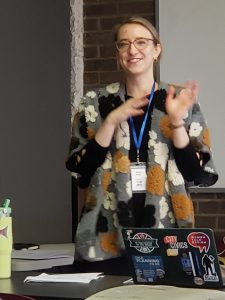When you feel sad, going outside helps to make you feel much better. Or not. It depends in large part on your surroundings. Urban planner Kelsey Zlevor, who researches the links between mental health and outdoor space, shared her insights about how to make places more joyful, while also relaxing at a conference on combating loneliness and a follow-up workshop. The conference – Summit on Combating the Loneliness Epidemic – and workshop – Designing Places to Reduce Depression – took place on January 11 at Fairleigh Dickinson University.

Kelsey Zlevor led the workshop, Designing Places to Reduce Depression.
The Northern New Jersey Community Foundation sponsored Zlevor’s conference session and workshop. The Community Chest of Eastern Bergen County produced the conference. The Designing Places to Reduce Depression workshop showed participants how to make places more joyful.
Designing Places to Reduce Depression
Participants learned about what Zlevor says are four principles for designing places that can help address depression. These principles include:
- A sense of ease. This makes people feel comfortable and also safe in the place. Zlevor noted typical park benches make it difficult for people, who are hearing impaired, to have conversations with people next to them. A curved bench resolves this issue.
- A sense of observation. This design principle gives people interesting things to see. Furthermore, this provides people the opportunity to connect to activities without having to be in the center of them. For example, installing seating areas around places with a lot of activity for people, who want to watch, allows others to sit, who otherwise would not participate.
- A sense of affinity with nature. This gives users of place opportunities to interact with plants and water features, as well as other elements of nature. They do not just see them from a distance.
- A sense of awe. This provides art and other elements that stimulate the senses. In addition, this principle helps people become more mindful – or to disrupt harmful thoughts.
Participants in Zlevor’s conference session – Innovative Approaches for Creating Connections through Creative Placemaking – learned about these principles. Furthermore, they explored how people, with what Zlevor calls ‘psychological disabilities’, experience places.
Strategies to Use

The Place It! approach encourages people to design spaces using arts and craft supplies and toys.
In the Designing Places to Reduce Depression workshop, participants explored strategies to put these principles into action. In addition, they practiced a model for engaging people to help shape the design of spaces. The Place It! approach encourages people to design spaces using arts and craft supplies, as well as children’s toys.
The participants in the workshop also engaged actively. For example, one participant said she came up with an idea for brightening up a local park in winter. Furthermore, two others (one a landscape architect and the other the director of a nature center) said the workshop gave them ideas to enhance the spaces they oversee.
For more information about Zlevor’s work, visit her website. Zlevor, who is based in Chicago, works for Muse, a woman-owned urban planning consulting firm.
She discusses her approach to place design in an interview with NNJCF’s Executive Director Leonardo Vazquez. Watch the recording online.